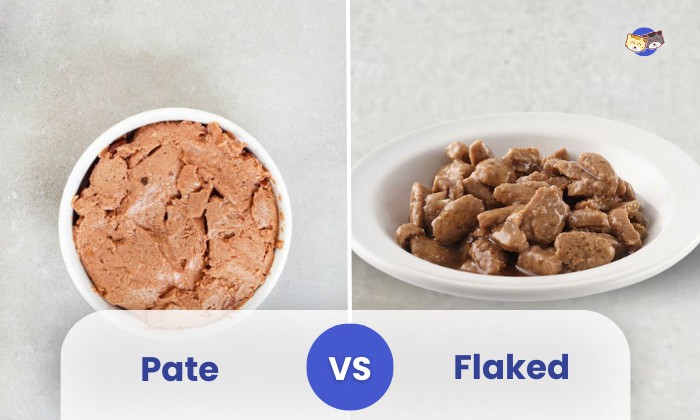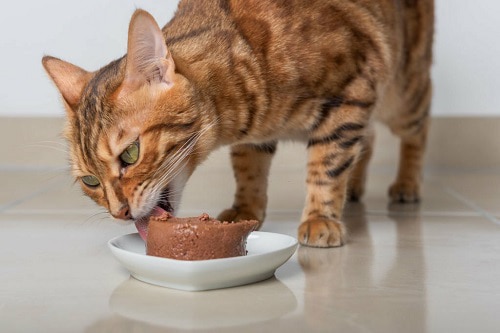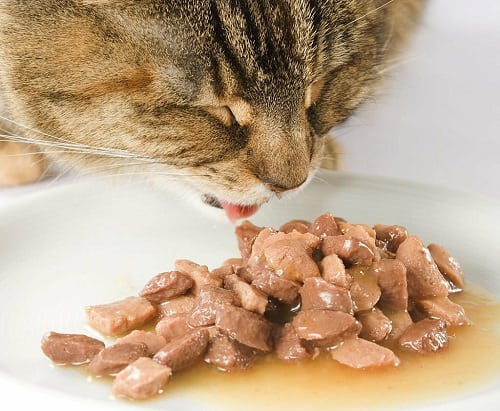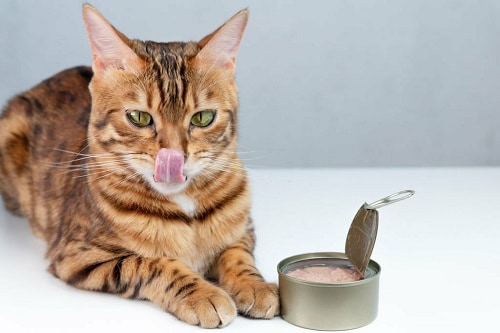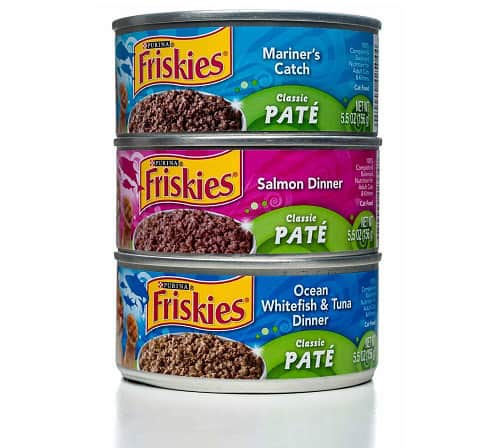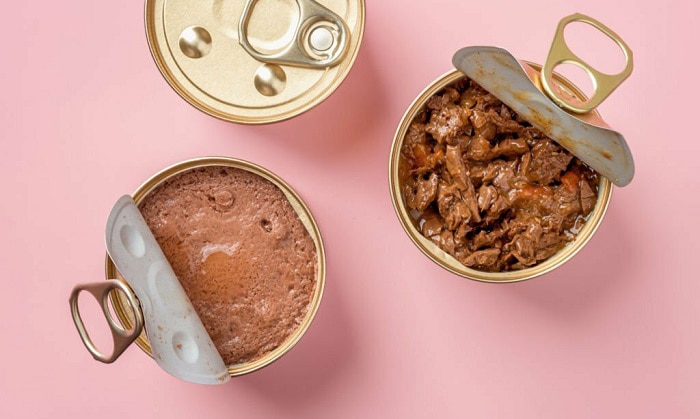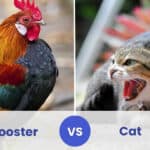Selecting the right cat food is crucial for your pet’s health and happiness, but with numerous options on the market, the choice can be bewildering.
In this article, we aim to unravel the pate vs flaked cat food dilemma. This comparison will help you understand the advantages and disadvantages of each option, as well as the differences between them, enabling you to make well-informed decisions.
Before we dive in, let’s take a quick look at a comparison table highlighting key distinctions between pate and flaked cat food:
| Pate Cat Food | Flaked Cat Food | |
| Texture | Smooth and creamy | Softer, flakier |
| Moisture Content | 75-78% | 70–75% |
| Flavor Options | Wide range | Wide range |
| Nutritional values | More rich in protein | Not as rich in protein, but also contain fewer additives |
Table of Contents
Overview
1. Pate
Deriving from a French word meaning “paste,” pate is a wet, puree-like food mashed up to have a gooey, gravy-like consistency.
This wet pate’s thickness varies, depending on the preparation, and does not contain meat chunks or shreds, which is especially good for kittens.
- Good for cats with distinct health needs
- Best option for older cats and kitten food
- A sly trick to deal with cat’s picky attitude
- Packed with nutrients and proteins
- May contain filler ingredients
2. Flaked cat food
Flaked cat food is made up of long and small flakes of protein – either fish or meat – floating in a light broth or gravy. Unlike pate, flaked cat food is not ground up or mashed, hence why you can still see the meat shreds/chunks.
This shredded cat food is carefully prepared to ensure it’s both delicious and nutritionally balanced. This thoughtful preparation guarantees that your cat enjoys a meal that’s not only tasty but also promotes their overall well-being.
- Textured delights for felines, especially a picky kitty
- Protein and nutritional boost
- Crafted for feline satisfaction
- Age and dental health considerations
- Risk of nutritional imbalance
Which Type of Wet Cat Food is Right for My Cat?
The choice between pate and flaked cat food depends on your cat’s individual preferences and needs. Consider the following factors:
1. Texture
The wet cat food textures of these options vary significantly. Pate cat food, with its smooth and creamy texture, suits cats who enjoy a velvety meal or those with dental issues.
In contrast, flaked cat food offers a flakier texture, making it a great choice for pets who appreciate some variety in their dining experience. Therefore, this gravy cat food is excellent for picky felines.
2. Flavor
Both pate and flaked cat food offer a wide range of flavors, such as seafood, chicken, beef, turkey, etc. However, since the latter comes with additional sauce or gravy, it may taste more palatable.
What’s more, as pate is blended, it’ll have a more consistent flavor throughout the food, whereas flaked food’s flavor may depend on how saturated with gravy the meat shreds are.
3. Moisture Content
Pate cat food, with its moisture content typically ranging from 75% to 78%, plays a vital role in preventing dehydration and supporting kidney health for cats.
In contrast, although flaked cat food is contained in broth or gravy, its moisture content is actually slightly lower than pate. You can expect this diet type to have a moisture content of 70-75%.
What’s more, there’s a chance that your cat will not lick the broth or gravy that flaked food is contained in, so the actual liquid it consumes may be even lower.
4. Nutritional values and health consideration
In general, pate cat food is more calorie-dense and protein-packed, which is essential for developing kitties and pregnant cats. However, this food type is more likely to contain fillers such as corn or wheat – additives that some felines may be allergic to.
On the other hand, flaked cat food is not as nutrient-packed, but there’s a lower chance of it containing additives.
Tips for Switching or Combining
Transitioning your cat to a new diet is a step-by-step process that takes about a week to ten days. The goal is to avoid surprising your kitty’s tummy with sudden changes. Here are what you can do:
- Start by mixing 25% of the new food with 75% of the old one and feed them this combo for a couple of days.
- Gradually increase the new food amount until it’s 50/50.
- After 2-3 days, shift to 75% new food and 25% old food.
- After another 2-3 days, make a full transition to 100% of the new food.
If the digestive issues persist, it’s a good idea to chat with your vet for some guidance to ensure your cat’s tummy is happy and healthy.
Conclusion
The array of options on the market can be overwhelming. However, now that you’ve learned the differences between pate vs flaked cat food, you can confidently serve up the perfect meal for your furry friends, especially for your picky eaters.

I am Amy Sawy, a Doctor of Veterinary Medicine (DVM) graduate from the University of Kansas. y husband, Dr. Plummer, and I own a veterinary clinic in Phillipsburg, Kansas. In addition to my professional background, I am a devoted pet owner myself, with a household that includes dogs, rodents, and most notably, cats – a total of five felines in my home.
In 2020, I joined an organization as a professional writer, leveraging my experience and collaborating with my team to deliver the most valuable information for your cat’s care.


